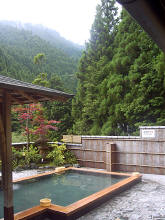On a chilly, winter morning with snow flakes falling softly, and steam rising from the water, a Japanese women in her sixties looks at me and exclaims, ‘hotto, hotto’, smiling wide, her eyes creased with wrinkles, as she eases herself into the water of a Japanese outdoor hot spring (onsen). We exchange few words, but both of us savor the feeling of time standing still as we let the water work its magic on us.
An onsen is a natural, mineral-rich hot spring where Japanese people have gone to soak away their aches and pains for centuries. This national obsession makes sense, since they are more abundant in Japan than any other country in the world, with over 2,300 of them scattered throughout Japan’s thermally active islands.
Many of Japan’s best onsens are located in remote areas, such as Hokkaido. But, if you’re in dire need of a good soak somewhere within easy reach of Kyoto, Japan then a visit to the ever-picturesque Kurama Onsen is your best option. While certainly not Japan’s best onsen, Kurama is the closest to Kyoto, offering tourists visiting the old capital a good chance to experience one of Japan’s most distinctive customs – public bathing. It’s also a good place to go to get a look at rural Japan.

 Kurama Onsen, flanked by cedar and pine forestsIf possible, try and make it up to Kurama during the week, when you can enjoy the experience at your leisure and you can enjoy walking along pathways that wind around streams in the village of Kurama. The village itself is picturesque, with lots of bamboo-slatted houses, and small eateries offering traditional fare. The train trip is also a highlight, with the seats placed facing the windows so you can enjoy the scenery as the two-carriage train winds itself up to Kurama village. You can also combine hiking with hot springs by walking from near-by Kibune through a valley and up to the Kurama-dera mountain temple, founded in 770AD, and then on to the onsen.
Kurama Onsen, flanked by cedar and pine forestsIf possible, try and make it up to Kurama during the week, when you can enjoy the experience at your leisure and you can enjoy walking along pathways that wind around streams in the village of Kurama. The village itself is picturesque, with lots of bamboo-slatted houses, and small eateries offering traditional fare. The train trip is also a highlight, with the seats placed facing the windows so you can enjoy the scenery as the two-carriage train winds itself up to Kurama village. You can also combine hiking with hot springs by walking from near-by Kibune through a valley and up to the Kurama-dera mountain temple, founded in 770AD, and then on to the onsen.
Just remember onsen etiquette. Make sure you wash your body thoroughly before dipping into the water, and make sure you don’t have a trace of soap on your skin when you enter the bath. Just watch the way the Japanese almost scrub themselves raw before dipping into the water. Finally, make sure to make your exit if you start feeling a little light-headed or faint. Most importantly, enjoy what is easily one of Japan’s most enjoyable and ancient offerings.
The bath costs just 1,100 yen (about $11 American dollars) and is open from 10 a.m. until 9 p.m. each day.
Getting There
Take the Eiden Eizan line from Kyoto’s Demachiyanagi Station. A one-way ticket costs 410 yen. For Kibune get off at the second last stop, for Kurama get off at the last stop on the line. There is a free shuttle bus which leaves every 30 minutes from the station to the hot spring. From Kyoto Station the trip takes about 46 minutes.